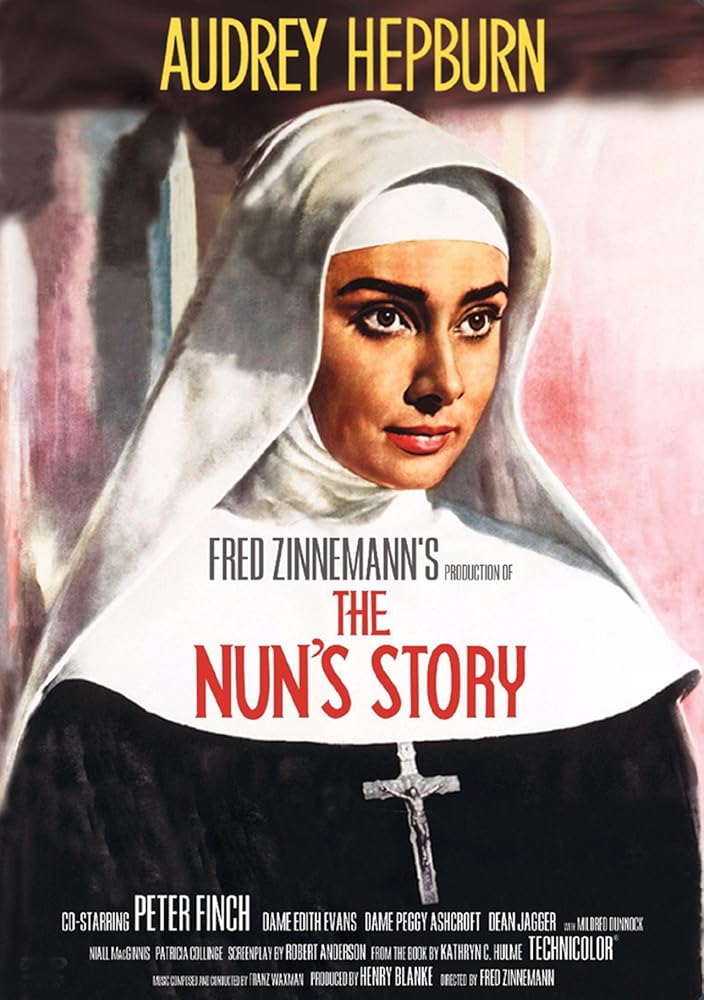
NUN’S STORY, THE
(director: Fred Zinnemann; screenwriter: Robert Anderson/from the novel by Kathryn Hulme; cinematographer: Franz Planer; editor: Walter Thompson; music: Franz Waxman; cast: Audrey Hepburn (Gabrielle Van Der Mal/Sister Luke), Peter Finch (Dr. Fortunati), Edith Evans (Mother Emmanuel Superior General), Dame Peggy Ashcroft (Mother Mathilde), Dean Jagger (Dr. Van Der Mal), Mildred Dunnock (Sister Margharita), Patricia Collinge (Sister William), Colleen Dewhurst (Archangel Gabriel, asylum patient), Lionel Jeffries (Doctor Goovaerts), Niall MacGinnis (Father Vermeuhlen), Beatrice Straight (Mother Christophe), Ruth White (Mother Marcella); Runtime: 149; MPAA Rating: NR; producer: Henry Blanke; Warner Home Videos; 1959)
“… on target and godlike.“
Reviewed by Dennis Schwartz
A mostly forgotten pic today but in its day it was the most successful movie Warner Brothers ever made, with grosses surpassing the $7 million mark.Director Fred Zinnemann (“High Noon”/”A Hatful of Rain”/”Oklahoma!”)keeps this serious film on the selfless inward religious life for the devout, set in the 1930s and 1940s, on target and godlike. It’s a difficult task, indeed, to mount a Hollywood pic on the inner-life struggles of a conflicted nun, who feels she doesn’t have the proper humility to serve God and much to his credit Zinnemann does it without gloss in an understated way.
It’s based on the factual best-seller novel by Kathryn Hulme and is written byRobert Anderson. It was filmed on location in Central Africa. I found it more tolerable than I expected, considering the subject is so gloomy, the musical score by Franz Waxman is so nauseating, and the drama is more book worthy than cinema friendly. Even though I respected the filmmaking, I still found the tasteful character study too long and at times too inert to get excited over its mild reflections over the battle to gain humility and that nuns also have human desires for love and family and are capable of leaving the convent when push comes to shove.
The film was not without controversy, as the Catholic Church raised objections – targeting that “the story of a dedicated nun leaving the order would not be good for recruitment.” Dominican advisers reviewed the script, debating the use of phrases such as “against Nature” vs. “above Nature.” Though the film was certainly not anti-Catholic, it didn’t offer the Church in either a friendly familiar lighthearted comical or a glowing reverential light as most Hollywood pics did back in the day–it was not afraid to expose its dark side without stereotyping its authority figures.
It’s the simple story of the Belgian girl Gabrielle Van Der Mal (Audrey Hepburn), from Bruges, a respected surgeon’s (Dean Jagger) daughter whose dream was to serve in the Belgium Congo as a nurse and who later finds some fulfillment in being a missionary nun.
The headstrong Gabrielle takes the nun’s vow and goes by the name Sister Luke. Trained in nursing school, Sister Luke finds it difficult to abide by the strict rules of the Order–such as their rules for silence. After nursing school, Mother Marcella (Ruth White) accuses Sister Luke of having too much pride and purposely assigns her to an asylum in Belgium instead of the Congo as requested. Sister Luke tries to be dedicated in serving others, but is nearly killed by a dangerous schizophrenic mental patient (Colleen Dewhurst) after she thought that she could control the patient by not going by the book in carrying out procedures. After some three years, Sister Luke’s sent by the Mother to the Congo and is assigned to work for the gruff dedicated chief-surgeon, Dr. Fortunati (Peter Finch), in the white hospital for the Europeans instead of working with the natives as desired. The handsome agnostic bachelor doc gets her to let go of her idealism and become more practical-minded, and takes her along to a leper colony. The hard-working nun, meanwhile, back in the hospital contacts tuberculosis while working around the clock. Through Dr. Fortunati’s efforts, Sister Luke recovers and is taken off duty for some R&R and is sent back to Europe to accompany a patient. Sister Luke is then ordered by Reverend Mother Emmanuel (Edith Evans) to return to the convent. When World War II erupts, Sister Luke follows the edicts of her order and does not take sides. This becomes nearly impossible when in occupied Belgium her beloved widowed dad is executed by the Nazis for aiding refugees to escape. Wth that jolt, Sister Luke realizes she made a wrong career choice and leaves the order to return to an uncertain “civilian” life.
Hepburn gives the ultimate performance of her career, in a part she was born to play. Though nominated for an Oscar, she lost to Simone Signoret (Room at the Top). Some thirty years later Hepburn returned to Africa to help the underprivileged, a cause she stuck with for the rest of her life.
REVIEWED ON 4/12/2010 GRADE: B